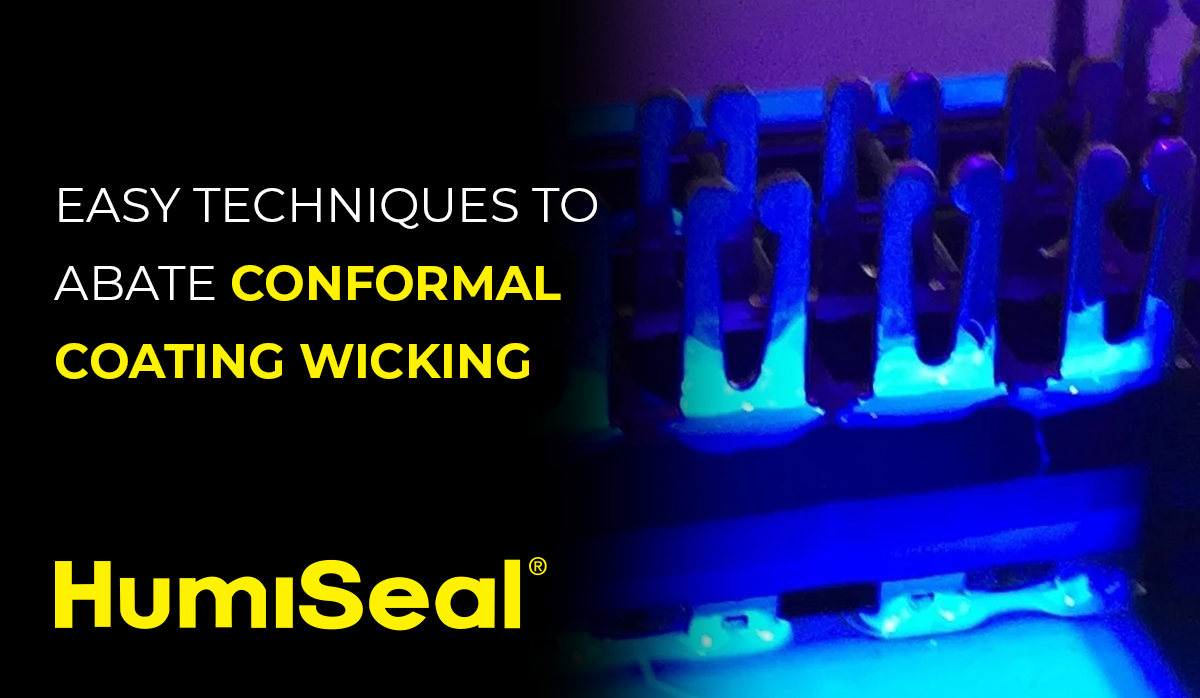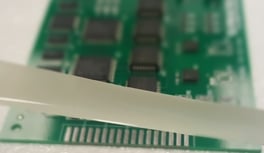
Have you ever experienced uncontrolled conformal coating migration? Have you had to strip your recently coated boards because conformal coating wicked into non-desired keep out zones? Wicking is a phenomenon caused by a combination of low surface tension coating, which is usually characterized by low viscosity, coupled with strong capillary forces generated by low standoff gaps possessed by the SMT process. Wicking into connectors; onto grounding hole; or under sensitive components will create defects that will have to be reworked, as it may cause reliability concerns with the finished product, which we will describe in detail. There are ways to either reduce and/or eliminate wicking issues through decisions made during preparation, application, and conformal coating selection.
Conformal coating wicking will create various defects depending on your PCB design:
- Damage to sensitive components during usage. Wicking of coating onto grounding holes or gold fingers is a common defect. This defect is easily reworkable while the coating is still wet, but can cause some headaches post cure.
- More critical conformal coating keep out zones are connectors that are sensitive to underfilling. As coating settles on individual pins, we see this type of defect. Reworkability of these is considered medium to difficult due to hard to get into spaces.
- Sensitive component underfill, such as all variants of BGAs, may cause defects up to solder joint failures. Rework of these requires extensive stripping of conformal coating, as small spaces are very hard to get into with chemical removal compounds.
- Furthermore, some conformal coatings can only be removed mechanically or with soldering iron, which makes wicking rework that much tougher.
How to spot wicking?
The best and quickest way to determine whether or not you may have a wicking issue is visual inspection of coating soon after application, preferably using a black light (if the coating contains a fluorescing agent). What if it does not? It is highly recommended that you check very early into the production run (see “first piece inspection” below under Preventive Measures).
A costlier method would be to wait until boards are tested for functionality. The majority of such instances results in root cause failure which is unwanted wicking into undesirable areas/components on the circuit board. Relying on this latter method is neither process nor cost efficient. Taking preventive steps in order to assure that wicking does not occur initially is always the best and most preferred approach to mitigate.
Preventative Measures:
Common steps to block/dam the coating therefore preventing it from creating various defects which result in wicking includes the use of:
- Masking materials, such as tapes and dots to mask connectors, fingers, and grounding holes
- Utilization of preformed boots to isolate hard to tape larger components
- Applying damming compounds/gels around keep-out zones. These work very well near connectors and small sensitive components
- And, always incorporate a first-piece inspection step into your application process in order to verify that your preventative measure(s) is/are effective


Corrective Measures:
If your preventative measure falters or you do not have the opportunity to implement one into your process, then there are several corrective steps that may be taken, either separately or in concert:
- Increasing viscosity of the liquid conformal coating in order to increase surface tension which will reduce wicking potential
- If increase of viscosity in the existing coating is not possible, selecting a different conformal coating (with advanced rheology characteristics) may be an option.
- Application programming changes may be necessary. For example, applying the conformal coating with higher atomization pressure to reduce susceptibility to wicking.
Checking and verifying whether or not reducing film thickness is possible. Minimizing applied wet film thickness will minimize the coating’s potential for undesirable flow due to capillary forces.
Wicking is a simple defect that commonly plagues both novice and advanced users of conformal coatings. This defect is preventable with simple planning steps and an understanding of critical keep out areas. Remember, the coating selection process is a critical part of wicking prevention, while coating use in combination with an appropriate complementary gel compound may be a viable wicking elimination solution.
Need to know more?








